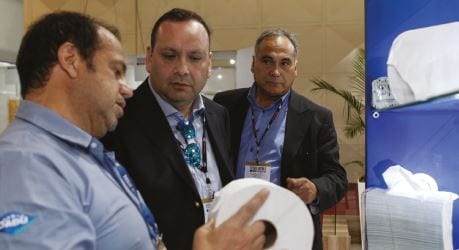The South American tissue industry gathered in São Paulo to attend the only key meeting point for the region’s growing and dynamic tissue market. TWM reports on some of the key talks from the event’s leading conference sessions.
Tissue World São Paulo: second edition attracts key players in growing Southern American tissue market
The South American tissue industry has gathered in São Paulo to attend the only key meeting point for the region’s growing and dynamic tissue market. It was the second edition of Tissue World in São Paulo, after the successful launch edition held in 2015.
Some 932 key participants took part in the event including 40 exhibiting companies with 144 exhibiting staff, 493 local visitors, 148 international visitors and 80 conference delegates.
The show was launched to respond to the growing demand for tissue products in South America, a fast-growing market that did not previously have an event dedicated to the tissue industry.
It took place between 31 May – 2 June at the Transamerica Expo Center in one of Brazil’s most vibrant financial cities. The trade show offers wide-reaching networking opportunities and a new viewpoint on the region’s fast changing tissue market.
Whether on the show floor with the many exhibitors or in the conference with the impressive line-up of expert speakers, participants had the opportunity to network with key industry players and explore the latest technical developments to find out what’s changing in the industry and how they can keep their company ahead of the curve.
Tissue World São Paulo included three busy days filled with conference presentations and show visits.
Conference targets potential in Southern American tissue market
Speakers at the Senior Management Symposium kicked off the conference sessions which were themed: ‘Challenges and opportunities: Approaches to accelerate the success.’
The sessions discussed the latest opportunities and challenges in Brazil and the surrounding regions. They were designed to show approaches to accelerate success and discussed micro – and macroeconomic outlooks and perspectives, logistics, trade flows, pulp and sustainability, market opportunities, tax expertise and finished product trends.
The functional and hands-on Technical Sessions followed on 1-2 June and covered the latest and most relevant information and case studies, presented by tissue industry experts.
Conference sessions: SENIOR MANAGEMENT SYMPOSIUM

Pedro Vilas Boas, director, Anguti Estatística, Brazil
Tissue made up 12% of Brazil’s total paper production in 2016 – an increase of 111% from tissue production in 2000. Packaging/wrapping made up 52%, printing/writing 25%, cardboard 7% and others for the remaining 5%.
Between 2010-2016, while GDP growth was at an all time low of 1.2%, tissue still grew by 5.7%. This compared to a GDP growth of 3.3% between 2000-2009 when tissue grew 4.3%.
Of the 1.262.000 tonnes of tissue produced in Brazil in 2016, domestic sales contributed to 1.254.000 tonnes.
Some 45.8% of tissue factories are located in Sao Paulo and Santa Catarina. The south of Brazil produces 44% at 559.656 tonnes, the northeast produces 44% with 550.320 tonnes, while the north, northwest and midwest produce 12% with 147.646 tonnes.
For paper brands, while 68% of toilet paper products were 1-ply and 32% were 2-ply in 2005, some 44% were 1-ply and 56% 2-ply in 2017.
Outlook for 2017-2018: Growing market with low profitability; constant market share dispute; impact of a powerful new player.
Macroeconomic perspectives: spotlight on Brazil and Latin America
Fernando Camargo, director, investment and corporate finance, LCA Consultores, Brazil
INTERNATIONAL ENVIRONMENT
Pro-Euro French vote outcome: Emmanuel Macron’s victory in the French Presidential election (despite recordsetting abstention numbers) reduces concerns over the block coming apart. Notwithstanding, Macron will have a huge challenge before him in the sense of securing a congressional majority to put his proposals into practice, as his party was founded just one year ago.
Activity in Europe picking up: leading activity indicators point to the most favourable prospects in six years.
Rising uncertainty in the US: Activityis losing momentum and political uncertainty is on the rise in the second quarter. President Donald Trump has lost popularity and governability after defeats in Congress.
DOMESTIC ENVIRONMENT
Labour Reform with a favourable vote: with 296 votes for (and 177 against), the scoreboard in the Lower House was better than expected and close to the 308 votes needed to pass the Social Security reform.
However, recent corruption accusations involving President Temer had a strong impact and the reforms are now in standby; the Temer government struggles to survive.
Presently the most probable outcome of the political crisis is Temer’s deposition by mid-June because of accusations of fraudulent campaign financing; Congress should then elect a new president, probably someone that until now supported the present government.
Global outlook: growth picking-up led by manufacturing activity in advanced economies, amid high political uncertainty, especially regarding Donald Trump’s policies, which is the main risk to this current relatively benign global macroeconomic environment.
Fiscal stimulus could boost US economy in the short-run … but could also spark inflation – specially if accompanied by protectionism (higher import prices), in a context where the economy is approaching full employment (higher wage growth).
Global outlook: growth to return to a lackluster pace in the medium term.
The Federal Open Market Committee is expected to (moderately) speed-up the pace of monetary normalisation in the 2nd half of 2017 – an event that can weigh on global markets.
US and global economies expected to return to a lackluster growth in the medium term, as monetary stimulus is gradually reversed in most advanced economies.
Latin America underwent a period of significant economic slowdown: exchange rate devaluation, accelerating inflation trend and sharp economic slowdown.
Various shocks were responsible for the deterioration of the Latin American macroeconomic environment: external shocks, such as the USD appreciation and the “Trump-effect” (with a strong impact on Mexico); internal political crises (mainly in Brazil, Venezuela and Argentina); and a sharp commodity devaluation (with particular impact on Colombia, Peru and Chile).
Economic performance in Latin America is expected to remain somewhat subdued, once the outlook for commodity prices is lackluster (due to a slower Chinese demand for industrial inputs; to interestrate hikes in the US and Europe; and to initiatives aimed at shrinking global liquidity.
Although India is replacing China as the fastest growing Asian economy, the net effect of these economic trends on commodity prices is expected to be modest in the near to medium term.
Besides the lackluster outlook for commodities, fiscal restraint is expected to weigh on Latin American growth in the near to medium term, as many countries are embarking on a period of fiscal consolidation.
On the other hand, inflation is slowing (helping to improve real income) and monetary conditions are being relaxed (which helps to reactivate the credit spigot) in most Latin American countries (especially in Brazil and Colombia) – a positive for domestic consumption.
All in all, outlook for Latin America points to improving performance in coming years, but growth should remain somewhat subdued, far from the pace of expansion that had been observed until the beginning of this decade.
Favourable external conditions have recently improved the economy´s terms of trade, mostly due to commodities’ appreciation.
Although President Temer is unpopular, executive branch dominance has been restored in Congress. But renewed political turbulence put structural reforms (social Security, Labour regulations) in standby; Congress should now take more time to approve the reforms and/or will approve less ambitious versions of them.
Brazil: currency appreciation, disinflation and monetary easing.
In these relatively favourable (external and domestic) circumstances, Brazil’s market risk assessment has been improving markedly. Better terms of trade and risk perception, plus high interest rate differential, have induced a significant currency revaluation, rapidly easing inflation pressures.
Both inflation and inflation expectations have receded towards target, leaving ample room for monetary easing: policy rate expected to reach a neutral bias (estimated to correspond to a 9% to 10% policy rate) before year-end.
Lower inflation and monetary easing help to explain why confidence is recovering in almost every sector of the economy, despite a still depressed economy, in which resource idleness continues very high – a negative for investments (and, thus, employment).
Brazil: consumption to lead the somewhat sluggish) recovery.
Besides, lower interest rates should help to clean up consumer’s balance sheets (once interest payments have become a burden for households in recent years).
Under improving fundamentals, consumption is expected to lead the recovery, that should remain somewhat sluggish in 2017 and pick-up from 2018 onwards.
Resumed growth will come, at first, from household consumption (as a result of decelerating inflation, lower interest rates, increased confidence and the release of R$ 43 billion in FGTS funds) and exports (more competitive exchange rate and modest word recovery l), as well as farming (better weather conditions) and mineral extraction (having overcome the negative effects of Samarco and taking into account a new Vale mine).

High idleness should keep investments low; the big unknown is on the infrastructure front.
Barbara Mattos, Vice President, senior credit officer, Moody’s Latin America, Brazil
Global paper and forest products outlook – stable. Operating income growth from packaging and wood products offsets commodity paper decline.
What could change the outlook to negative –
• If consolidated global operating income declined over the next 12-18 months
• Increased input costs that cannot be passed on to customers, or reduced prices as a result of operating capacity in excess of demand for several grades.
Operating earnings of the 46 rated companies will grow 2% – 4%
• North American wood product producers will benefit as US housing starts grow 8%
• Commodity paper producers continue to face 5% demand declines as digital alternatives replace paper.
• Increasing consolidation will reduce some earnings volatility.
• Global GDP (G20) will grow about 3% in 2017.
What could change outlook to positive –
• If consolidated global operating income increased by more than 4% over the next 12-18 months.
• Higher prices across several major grades (such as paper packaging) and regions due to tight demand-supply balance or higher than expected GDP growth.
The industry’s global operating income will increase 2%-4% over the next 12 months with operating income growth from paper and forest products producers in North America and Latin America, and from 1% to 3% in Europe.
Global Paper & Forest Products Subsector Outlooks:
Paper packaging and tissue – stable.
Share of consolidated operating income – 50%.
Operating earnings to grow about 2%
• Higher North American paper packaging prices offset by higher recycled fibre costs and lower tissue prices.
• Packaging demand driven by modest economic pick-up and stable food consumption.
• Tissue demand driven by population growth and improving hygiene standards.
Prices across most grades will increase during the first half of 2017, followed by weakening of prices in the second half as capacity increases outpace demand growth.
• As additional pulp capacity comes online, inventory management across the fragmented global pulp industry will remain critical to balancing supply and demand
• Latin American market pulp producers will continue to enjoy structural cost advantages over North American and Western European producers due to their large efficient mills and short tree – harvesting cycles
China’s growing paper and tissue production capacity continues to drive pulp demand.
Tissue and hygiene products industry benefits from lower demand volatility compared to other segments.
Retail tissue and hygiene products market still highly concentrated.
Top five producers hold about 65% of total market share in Latin America.
Tissue industry Brazil – growing per capita demand despite economic contraction. Brazilian tissue and hygiene products industry more competitive than Chile’s.
Brazilian tissue market: key trends and opportunities
Elton Morimitsu, research analyst, Euromonitor International, Brazil
Latin American market: Brazil remains the biggest market within tissue. Brazil not necessarily the biggest market in all categories… Informal stalls and taquerias supporting sales of napkins in Mexico; Convenience higher driving sales of paper towel in Peru.
Brazilian tissue market overview in 2016: USD2.3bn.
86% toilet paper; 10% paper towel, 2% facial tissues, 2% paper tableware.
Downgrade in consumer habits to influence forecast period.
Brazilian increasing purchases of premium products up to 2013/14.
Companies are adjusting their portfolios to the new scenario.
AfH market dynamics –
Business-to-business (B2B) transactions are characterised by tighter budgets and less relevance in product differentiation, which encourages establishments to choose cheaper products instead of picking the leading ones.
The main differentiation that manufacturers of AfH tissue and hygiene can provide is their service. Maintenance and delivery time are very significant in B2B negotiations, and therefore the most efficient players have competitive advantages.
Brazilian AfH market overview 2016: USD 597m.
58% AfH paper towel; 27% aft toilet paper; 12% AfH wipers, 3% AfH paper tableware.
AfH sales continued to post positive growth rates, despite the challenging economic scenario.
Growth rates could have been much stronger if industrial and services demand were stronger.
Wipers growth sustained by higher surveillance measures.
The National Health Surveillance Agency (ANVISA) determined the increase of usage of disposable wipers – hospitals, industrial kitchens and food service outlets are now obliged to use wipers for cleaning purposes.
The water crisis faced during a couple years ago also helped pushing sales up. Brazil still offers plenty of room to grow.
Focus on increasing penetration of existing categories….
… And expanding new products and features.

Tissue retailer and consumer insights, consumer purchasing patterns
Marco Aurélio Lima, business relationship director GFK, Brazil
Purchasing patterns of the current consumer: do more.. with the same.
2017 challenges – higher efficiency, increased profit, margins.
Consumer – new habits? Space for launchings? New products?
Brazilian consumer –
Had to stop and think of WHAT and HOW they bought and consumed; Adapted to the new reality. Tried new channels, new brands, new products and new usages… Acquired a more reasoned and critical attitude. Brazilian crisis has negatively impacted consumer confidence. Over the last five years, economic concerns have increased. Percentage of online activities related to the purchasing process: 78% – browse the best price. 66% – find the desired product and services. 66% – buy a product or service. 64% – search for information on products/services. 54% – see options. 30% – use social networks to exchange information. Online price comparisons empower the consumer.
Purchase behaviours have changed. From 1/3 in 2015 to nearly half in 2017 of people have stopped buying some categories, such as beer, soda and bleach and soy bean oil. What are the behaviour changes in times of crisis?
Purchase smaller packaging. Purchase only in case of special offer. Split the purchase. Purchase at lower frequency . Purchase smaller packaging Purchase only in case of special offer Split the purchase between brands they used to buy and other cheaper brands Shift to a more affordable/cheaper brand Change the purchase place to supermarkets offering cheaper prices. Prepare your company for new times. What has changed for toilet paper? Change of Brand and Channel Special Offer drives the purchase – even more intensely. The crisis has brought changes to brands in some categories.
In short –
1. Are our companies adapting to the new business dynamics of the post – CRISIS?
2. In what extent does the consumer consider your product relevant, or may replace your product with another, or even change the category?
3. What are the trends of our products and the most relevant channels?

























